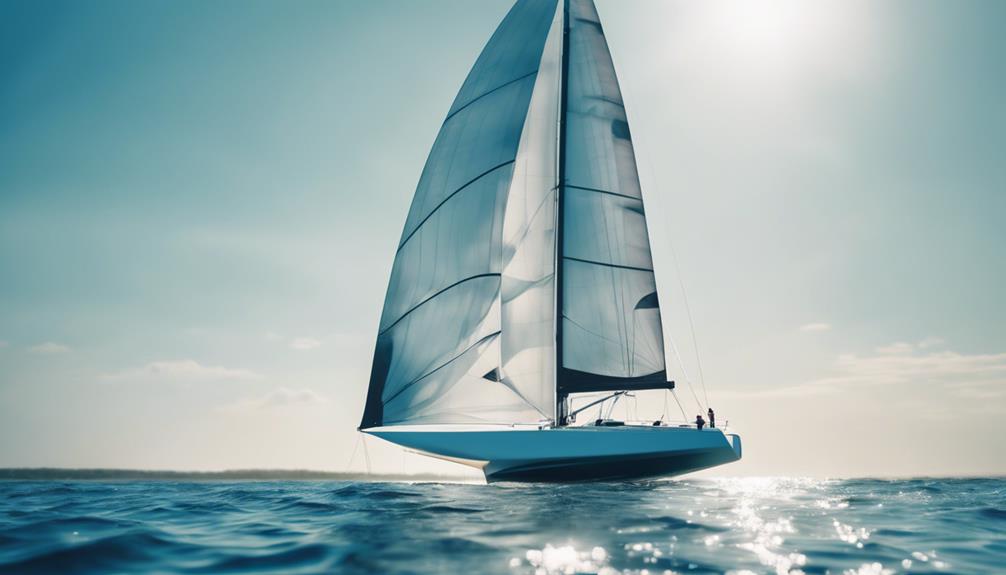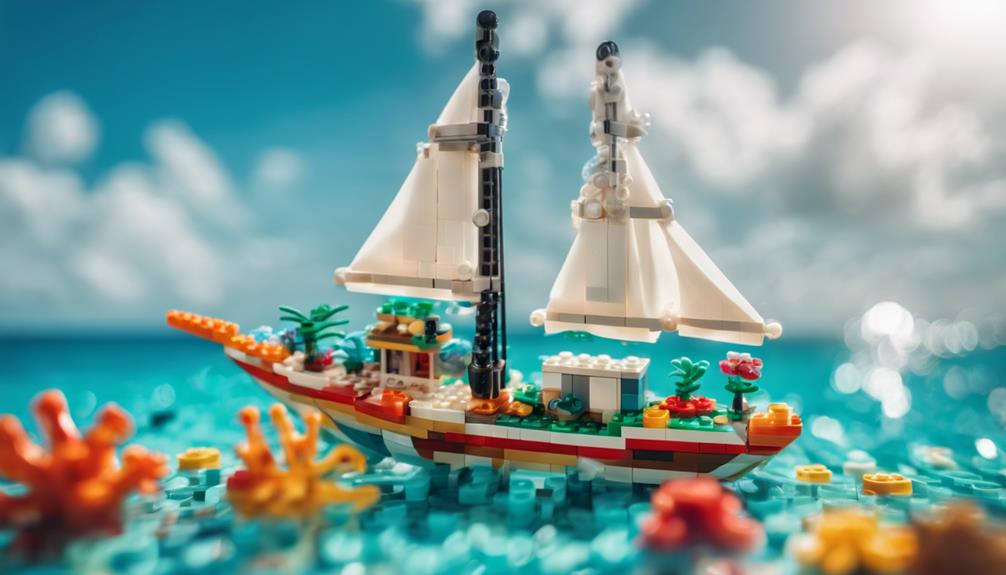If you're curious about the most expensive racing sailboats, search no further than the iconic J Class yachts. These masterpieces can set you back between $10 million and $20 million, with annual maintenance costs soaring to $3 million. Rich in history and craftsmanship, J Class yachts are not just boats; they're embodiments of luxury and competitive spirit. Events like the America's Cup highlight the high stakes and innovation in sailing, where technology and passion continuously push boundaries. Discover the allure of these elite yachts and the intense competition surrounding them, and you'll uncover even more fascinating details.
Key Takeaways
- J Class yachts, costing between $10 million and $20 million, are the most expensive racing sailboats, embodying luxury and craftsmanship.
- Annual maintenance for J Class yachts can reach up to $3 million, reflecting their high upkeep and performance standards.
- The America's Cup, the oldest international sporting trophy, drives innovation and competition among elite sailing nations, enhancing the prestige of yacht racing.
- Technological advancements like hydrofoils and advanced materials significantly improve yacht performance, making racing faster and more exciting.
J Class Yacht Overview
J Class yachts, with their stunning designs and rich history, represent some of the most prestigious sailing vessels in the world. These iconic boats were originally linked to the America's Cup, showcasing exceptional craftsmanship and engineering. The Universal Rule, established in 1930, formalized their design, enabling these majestic single-masted sailboats to compete at the highest level.
Today, only nine J Class yachts remain, and owning one is a significant investment, with purchase costs ranging from $10 million to $20 million. Annual maintenance can soar up to $3 million, reflecting the specialized components and expert care required to keep these vessels in peak condition.
The first J Class yacht, Shamrock V, launched in 1929 for Sir Thomas Lipton, set the standard for beauty and performance in sailing.
Restoration efforts in the 1980s reignited interest in J Class yachts, allowing historic models like Rainbow and Endeavour to return to competitive sailing. These yachts not only represent a bygone era of yachting but also embody the spirit and prestige of elite racing, making them timeless symbols of excellence on the water.
Historical Significance of J Class

The historical significance of J Class yachts lies in their unique design, purpose-built for the prestigious America's Cup, which has shaped yachting culture since the early 20th century.
Designed under the Universal Rule established in 1930, these yachts reflect the pinnacle of sailing innovation. By 1937, a total of ten J Class yachts, including the iconic Shamrock V, Rainbow, and Endeavour, were launched, each contributing to the lore and prestige of the America's Cup.
However, after the 1937 race, the America's Cup wasn't held for over two decades, leading to a decline in the popularity of J Class yachts. This decline didn't erase their legacy; restoration efforts in the 1980s reignited interest, allowing these historic vessels to return to competitive waters.
Today, only nine J Class yachts remain, making them incredibly rare and sought-after by yachting enthusiasts and collectors alike.
The blend of engineering excellence and rich history in the J Class yachts not only represents a significant chapter in competitive sailing but also continues to inspire new generations of sailors and designers in the world of yachting.
Modern Racing Competitions

Modern racing competitions like the America's Cup and SailGP showcase cutting-edge technology while demanding significant financial commitment from teams. If you're interested in yacht racing, you'll find that campaign costs often exceed $100 million, with operational expenses around $10 million per year for each team.
The thrill of these events is palpable, especially when you consider the J Class yachts linked to the America's Cup, which require custom components that can lead to repair costs as high as a home.
The introduction of the AC40 yacht, priced at $2.85 million, provides private owners a chance to compete in prestigious events, highlighting advanced technology in high-speed foiling. SailGP takes the excitement further with its F50 catamarans, each valued at about $4 million, capable of reaching speeds up to 54 knots.
These modern racing competitions aim to thrill audiences and attract new demographics, much like the buzz surrounding Formula 1 racing.
With every race, the stakes are higher, and the innovation in yacht racing continues to evolve, making it an exhilarating sport to follow and participate in.
Owner Insights and Financials

For those considering ownership of a racing sailboat, particularly a J Class yacht, understanding the substantial financial commitment involved is essential. These yachts aren't just for sailing; they represent a significant investment that demands both time and money.
Here are three key financial aspects you should consider:
- Initial Purchase Costs: Expect to pay between $10 million and $20 million for a J Class yacht.
- Annual Maintenance Expenses: Owners often face maintenance costs that can soar up to $3 million each year, ensuring the yacht remains in prime condition.
- Upgrades and Customization: The unique features and luxury interiors of these yachts lead to additional expenditures, as owners frequently invest in upgrades.
While the allure of ownership is strong, many owners prefer to keep their financials private, which contrasts sharply with the typical displays of wealth seen on social media. Discretion is key; the financial commitment is significant, and owners need to be prepared for ongoing expenses that reflect the high stakes associated with owning such prestigious vessels.
The Allure of J Class Racing

When you think about J Class racing, you can't help but appreciate the historical significance and engineering excellence behind these magnificent yachts.
Their luxurious features and amenities elevate the experience, making every race a spectacle of opulence.
Plus, participating in such a prestigious event connects you to the rich tradition of modern racing, creating an allure that's hard to resist.
Historical Significance and Excellence
The allure of J Class racing lies in its rich history and unmatched engineering excellence, enchanting enthusiasts and collectors alike. With only nine of these magnificent yachts remaining, each one is a proof of their historical significance and craftsmanship.
You can appreciate their legacy through three key aspects:
- Historical Impact: The first J Class yacht, Shamrock V, launched in 1929, marked the beginning of a prestigious lineage tied to the America's Cup, showcasing the evolution of competitive sailing.
- Engineering Mastery: The Universal Rule established in 1930 formalized the design of J Class yachts, leading to remarkable vessels like Rainbow and Endeavour, which are celebrated for their innovative structures and performance.
- Revival and Competition: Restoration efforts in the 1980s rekindled interest in these iconic yachts, allowing them to compete effectively in modern events, thereby preserving their legacy for future generations.
Owning a J Class yacht isn't just about the thrill of racing; it's about being part of a storied tradition that combines historical significance with engineering excellence, making it one of the most prestigious pursuits in the sailing world.
Luxurious Features and Amenities
J Class yachts consistently impress with their luxurious features and bespoke amenities, making them the epitome of opulence on the water. When you step aboard one of these magnificent vessels, you're greeted by interiors crafted from high-end materials that reflect your personal taste. Every detail matters, from the polished wooden decks to the stunning brass fittings, enhancing the overall aesthetic appeal.
These yachts aren't just about looks; they embody a unique blend of historical significance and engineering excellence. Owners often invest millions annually—not just in maintenance, but also in upgrades that guarantee their yachts remain competitive while exuding luxury. Each J Class yacht is a one-of-a-kind masterpiece, with custom amenities tailored specifically to meet the desires of its owner.
Whether it's a state-of-the-art entertainment system, a gourmet kitchen, or plush lounge areas, you'll find that the luxurious features are designed for both comfort and performance. The allure of J Class yachts lies in their ability to combine modern luxury with a rich racing heritage, attracting affluent enthusiasts who are passionate about sailing and the high seas.
Modern Racing Prestige
Experiencing the thrill of J Class racing offers a unique blend of rich history and elite competition that few other sports can match. With only nine remaining J Class yachts, these vessels aren't just boats; they're symbols of prestige, deeply intertwined with the legacy of the America's Cup.
Here are a few reasons why J Class racing captivates enthusiasts:
- Historical Significance: Designed under the Universal Rule of 1930, J Class yachts represent a pivotal era in sailing history, making each race a nod to tradition.
- Investment and Maintenance: The financial stakes are high, with these yachts costing between $10 million and $20 million to purchase and annual maintenance fees reaching up to $3 million.
- Craftsmanship and Luxury: Each yacht is a masterpiece, showcasing stunning wooden decks and brass fittings, merging traditional craftsmanship with modern luxury.
The passion of owners enhances the allure, as they view their J Class yachts not just as investments, but as vessels that embody a pursuit of excellence on the high seas.
In this world, luxury and competition collide, creating an unforgettable experience.
America's Cup Overview

The America's Cup isn't just a race; it's a rich part of sailing history that showcases intense competition among four winning nations.
You'll see cutting-edge innovations in yacht design that push the limits of speed and performance.
As we explore its significance, keep in mind how this prestigious event has evolved over the years.
Historical Significance of America's Cup
Established in 1851, the America's Cup stands as the oldest international sporting trophy, showcasing fierce competition among elite sailors and cutting-edge yachts. This prestigious event has a rich history that not only highlights the skill of sailors but also emphasizes technological advancements in yacht design.
As you explore the significance of the America's Cup, consider these key points:
- Innovation Driver: The competition has continually pushed the boundaries of marine technology, leading to the introduction of revolutionary designs such as hydrofoils.
- National Pride: Only four nations—USA, Australia, New Zealand, and Switzerland—have claimed victory, with Emirates Team New Zealand leading modern history with four titles.
- Cultural Impact: Historical rivalries and notable past winners have shaped the narrative, making the America's Cup a benchmark event in the sailing world.
As you look forward to the next edition, the 37th America's Cup scheduled for Barcelona from August to October 2024, it promises to further enhance the event's legacy, drawing global attention and showcasing the latest in sailing technology.
Notable Winning Nations
Four nations dominate the America's Cup, each with a unique legacy and competitive spirit that has shaped the event's storied history. The United States, Australia, New Zealand, and Switzerland have all claimed victory, showcasing their prowess in sailing and their commitment to this prestigious international competition.
Emirates Team New Zealand stands out with the record for the most wins in modern history, having lifted the trophy four times. Their success has made them a formidable force, inspiring other international teams to elevate their game.
The rivalry between the United States and Australia also adds a thrilling dimension to the Cup's narrative, with each nation pushing the other to innovate and excel.
As you look forward to the 37th edition of the America's Cup, set to take place in Barcelona from August to October 2024, you can anticipate the continued clash of these elite nations. Each competition not only tests sailing skills but also the strategies and technologies that international teams employ to secure victory.
The America's Cup remains a demonstration of the enduring spirit of competition among these sailing powerhouses.
Technological Innovations in Racing
Technological innovations have dramatically reshaped racing in the America's Cup, pushing the boundaries of what's possible on the water. The AC75 racing yacht stands at the forefront of this transformation, showcasing a blend of cutting-edge design and advanced engineering. With each iteration, teams leverage numerous technologies to enhance performance and speed.
Here are three key innovations that have redefined the racing experience:
- Hydrofoil Technology: The introduction of wing-like hydrofoils enables the yacht to lift above the water, effectively doubling race speeds and revolutionizing yacht design.
- Advanced Materials: Utilizing lightweight materials like Kevlar and carbon fiber in the construction of fixed-wing sails optimizes aerodynamics, allowing for better handling and speed.
- Data Analytics: Equipped with over 300 sensors, teams analyze 3,000 variables in real-time, generating 200 gigabytes of data daily. This technology informs strategic decisions, enhancing competitive edge during races.
These innovations not only elevate the performance of racing yachts but also engage fans, making the America's Cup an exhilarating spectacle of technological prowess on the high seas.
American Magic Team Aspirations

American Magic aims to reclaim the America's Cup, fueled by a passion for excellence and a commitment to innovation in sailing. Established in 2018, this team has a rich history to uphold after a 132-year absence from the Cup, and they're not backing down.
Despite facing a significant setback when their AC75 yacht, Patriot, capsized during the 36th edition, they're gearing up for the next challenge. In May 2024, they launched a new AC75 yacht, also named Patriot, as a demonstration of their resilience and ambition.
Investing over $100 million into this campaign illustrates the high stakes involved. Here's a quick overview of the key players and milestones:
| Year Founded | Key Team Members | Investment |
|---|---|---|
| 2018 | Tom Slingsby, Paul Goodison | Over $100 million |
| 2024 | New AC75 yacht launched | – |
| 36th Cup | Capsized during competition | – |
| 37th Cup | Preparing to compete | – |
With talent and determination, American Magic is set on a path to reclaim the prestigious America's Cup.
Technological Innovations in Racing

Revolutionizing the sport, the latest advancements in racing yacht technology have dramatically enhanced speed and performance on the water. Among these innovations, hydrofoil technology stands out, allowing yachts like the AC75 to lift above the water surface, reducing drag and increasing velocity. This remarkable shift in design has led to race speeds doubling since its inception, transforming competitive sailing into a high-speed spectacle.
Key technological innovations that have contributed to this evolution include:
- Monohull Design: The AC75 features a streamlined monohull with wing-like hydrofoils that optimize speed and maneuverability.
- Soft Wing Sails: Unlike traditional sails, soft wing sails enhance aerodynamic efficiency, enabling boats to sail faster and more efficiently.
- Advanced Data Collection: Winning yachts utilize over 300 sensors to analyze 3,000 variables every ten seconds, allowing teams to adjust their strategies in real-time.
With cutting-edge materials like carbon fiber and hydraulic systems, boats such as SailGP's F50 catamaran are pushing the limits, achieving speeds of up to 54 knots. These technological innovations are setting new standards in the world of yacht racing.
Economic Impact of Yacht Racing

Yacht racing has a profound economic impact, boosting local economies through increased tourism and job creation during major events. When prestigious races like the America's Cup or SailGP come to town, visitors flock in, and local businesses thrive. You'll find hotels booked solid, restaurants buzzing, and shops seeing a spike in sales, all contributing to a vibrant local economy.
Sponsorships from global brands pour in, with teams like American Magic attracting investments exceeding $100 million. This level of financial commitment showcases the high stakes of yacht racing and its ripple effects on local industries.
Operational costs for these teams, estimated at around $10 million annually, further drive spending in marine industries and event management.
Moreover, the competitive nature of yacht racing pushes innovations in yacht design and technology, fostering growth in the marine tech sector. You'll also see job opportunities sprout in hospitality, transportation, and marine services as cities prepare for these high-profile events.
Frequently Asked Questions
What Is the Most Expensive Sailing Boat?
The most expensive sailing boat is typically a J Class yacht, costing between $10 million and $20 million. Maintenance can add up to $3 million annually, reflecting its luxury and historical significance in sailing.
How Much Does a High End Sailboat Cost?
A high-end sailboat can cost between $2.85 million and $20 million, depending on its type and features. Maintenance and operational expenses can add millions more, especially if you're competing in prestigious events.
What Is a Large Expensive Boat That Is Used for Racing or Sailing?
If you're looking for a large, expensive boat for racing, consider the J Class yachts. Their luxurious designs and historical significance come with hefty price tags, often ranging from $10 million to $20 million.
How Much Does a Racing Sail Boat Cost?
Did you know some racing sailboats can cost between $8 million and $10 million? If you're considering one, don't forget to factor in potential maintenance costs, which can add millions to your annual expenses.
What Makes Expensive Racing Sail Boats Worth the Investment for Sail Boat Racing?
Expensive racing sail boats are worth the investment for sail boat racing because they offer top-notch speed, performance, and technology, making them perfect for thrilling sail boat race spectacles. Their advanced designs and materials give racers the edge they need to compete at the highest level, making the investment worthwhile.
Conclusion
In the thrilling world of high-stakes yacht racing, J Class yachts stand as symbols of elegance and competition.
Did you know that the most expensive J Class yacht ever sold fetched a staggering $45 million? This figure highlights the immense financial commitment behind these vessels, reflecting both their historical significance and modern allure.
As you watch the fierce rivalries unfold on the water, it's clear that the combination of innovation and tradition continues to drive the excitement of yacht racing.










